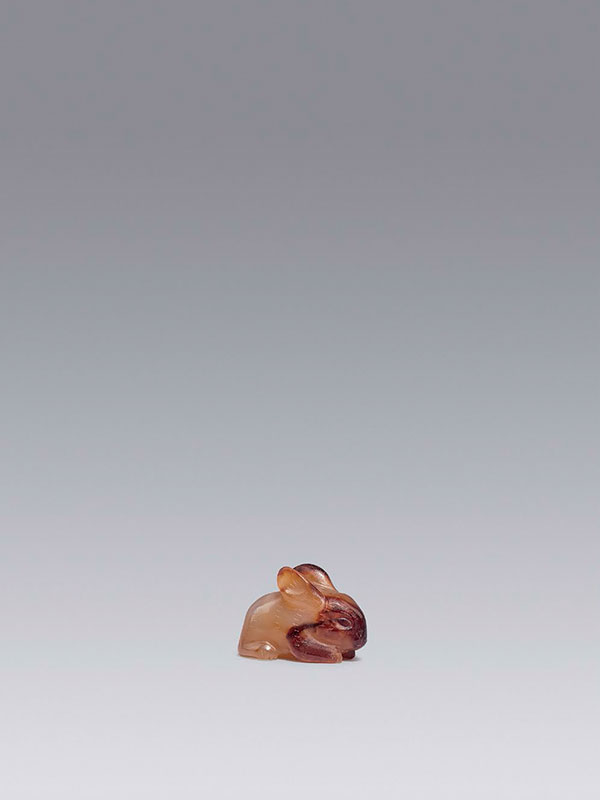Agate hare
An agate model of a crouching hare, naturalistically depicted facing forward in an alert position. The hare has its long ears folded back, bulging eyes and flared nostrils. The animal has a short tail and the details of the paws and hair are carefully incised. The mainly orange-red coloured stone is translucent in some parts, with some smoky brown and black lines. The surface of the stone is smooth and well polished.
Agate pieces grew in number among the jades from the Eastern Zhou period (770 – 256 BC) onwards, often incorporated into pendant sets to add more glamour to them. Agate ornaments were highly valued for their exceptional durability and glossy appearance, as well as their supreme workmanship. A hare or rabbit has long been a very popular animal in Chinese art; it has a special importance as a Daoist symbol associated with immortality and hence longevity. According to Daoist legend, a ‘moon hare (yuetu)’ lives on the moon together with the Goddess of the Moon, Change, with a mortar and jade pestle.[1] Beads or toggles in the form of a crouching hare, often with a perforation drilled through, were used from the Han dynasty (206 BC – 220 AD) onwards, such as a jade example in the collection of the Museum of East Asian Art, Bath.[2] Carvings of hare were often found as weights or as tomb models during the Tang dynasty.[3] The lifelike depiction of this alert hare is charmingly rendered and lends the animal instant appeal. A closely comparable yellow brown jade hare, smaller in size and dated to the Tang dynasty, is in the collection of the British Museum.[4] A later white jade hare similar in size and dated to the Song dynasty or later is in the collection of the Museum of East Asian Art, Bath.[5]
- Welch, P. B. Chinese Art – A Guide to Motifs and Visual Imagery, Tuttle Publishing, Singapore, 2012, p. 142
- Forsyth, A. and McElney, B. Jades from China, The Museum of East Asian Art, Bath, 1994, no. 153, p. 254
- Rawson, J. Chinese Jade – From the Neolithic to the Qing, The British Museum Press, London, p. 365
- Rawson, J. op. cit. no. 26:9, p. 365
- Forsyth, A. and McElney, B. op. cit. no. 210
瑪瑙臥兔
唐 618 – 906
長:5 公分
瑪瑙立雕小型兔,伏臥於地,雙目直視前方,大耳側垂於背,身體橫刻細線如毛髮,生動表現臥兔神
態。瑪瑙橘紅與透黃相間,表面打磨細緻,雖年歲久遠仍顯潤澤剔透。瑪瑙已於東周時與玉器同用於
配飾中。道教傳說中,月兔與嫦娥同住在月宮,並負責搗煉藥物,因而象徵長生不老。漢代迷你兔型
飾多有穿孔,且尺寸極小,刻工亦較簡約,如英國巴斯東亞藝術博物館即有一迷你玉兔。大英博物館
藏有一件黃玉兔,型態與本品相仿,定年為唐代。

